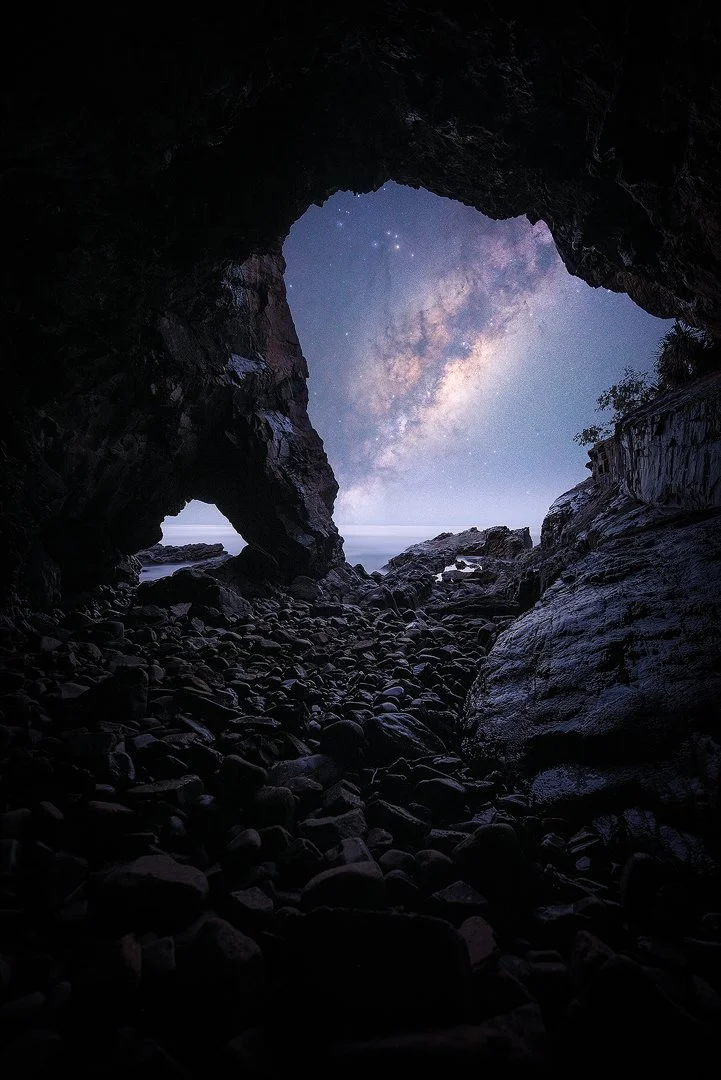Why Noosa belongs on your photo bucket list
More than 1.5–2.1 million visitors explore Noosa National Park each year, yet photographers still find quiet pockets of raw coastal beauty. West-facing headlands meet east-facing coves, giving you sunrise, sunset and Milky Way options within one compact trail network. Add world-class surf, turquoise tidal pools and easy access from Hastings Street and you have Australia’s most versatile coastal playground.
Table of Contents
Boiling Pot Lookout – Swirling Seascapes
Granite Bay – West-Facing Sunset Arcs
Fairy Pools – Tidal Reflections & Astro
Hell’s Gates – High-Vantage Panoramas
Tea Tree Bay – Golden Side-Light & Calm Water
Little Cove – Pastel Dawn Classics
Dolphin Point – Ocean Wildlife & Storm Drama
Alexandria Bay – Remote Minimalism
Planning Your Shoot
Join the Workshop
1. Boiling Pot Lookout – Swirling Seascapes
Best time: Sunrise, storm swells
Gear tip: 14–24 mm lens plus 3-stop ND for 0.5 s wave blur
Safety note: Stay behind the rail; rogue waves hit at mid-tide
GPS: -26.3997, 153.0934
Insider edit: Use range mask in Lightroom to warm highlights only, preserving cool water tones.
The Boiling Pot channels incoming surf through a narrow gulley, creating explosive spray and textured water movement. Pair an east-facing glow with foreground motion for gallery-ready drama. I revisit this spot on Day 1 of my Noosa photography workshop.
2. Granite Bay – West-Facing Sunset Arcs
Best time: Sunset, Milky Way season April–August
Gear tip: 24 mm prime on a star tracker for low-noise nightscapes
Safety note: Exit before high tide, slippery boulders
GPS: -26.3941, 153.1048
Insider edit: Blend a tracked sky with a blue-hour foreground for noise-free detail.
Granite Bay is rare on the Sunshine Coast: it faces west. Expect pastel sunsets over Laguna Bay and perfect alignment for sweeping Milky Way arcs. We often finish Day 2 here on the workshop.
3. Fairy Pools – Tidal Reflections & Astro
Best time: Mid-tide for reflections, new-moon astro
Gear tip: Polariser off, ND on for mirror-flat pools
Safety note: Only enter the pools on calm days; watch set waves
GPS: -26.3946, 153.1126
Insider edit: Dodge-burn wet rocks to add dimensional contrast.
The two natural pools act as foreground mirrors at 0.8–1.1 m tide. Under clear skies the Milky Way reflects perfectly. This location features on both my multiday itinerary and private sunrise sessions.
4. Hell’s Gates – High-Vantage Panoramas
Best time: Sunrise panoramas, winter swells
Gear tip: 70–200 mm for cliff abstracts
Safety note: Strong winds at cliff edge; secure tripod
GPS: -26.3952, 153.1178
Insider edit: Stitch a three-frame pano, then add subtle dehaze on sea spray.
Hell’s Gates offers 180-degree views from Alexandria Bay round to Laguna Bay. Low winter sun lights the cliffs side-on, revealing basalt textures.
5. Tea Tree Bay – Golden Side-Light & Calm Water
Best time: Early sunrise and first light
Gear tip: 35 mm for layered pandanus trunks and shoreline curves
Safety note: Monitor tide; waves wrap quickly around rock ledge
GPS: -26.3966, 153.1019
Insider edit: Lift mid-tones selectively to reveal submerged sand ripples.
Protected from southerlies, Tea Tree delivers glassy water and amber side-light. Great for handheld composition drills before breakfast on Day 3.
6. Little Cove – Pastel Dawn Classics
Best time: Nautical dawn to sunrise
Gear tip: Use a soft-grad ND to balance horizon glow
Safety note: Steep stair access, allow extra time
GPS: -26.3940, 153.0894
Insider edit: Apply split-toning (warm highlights, cool shadows) for painterly pastels.
Little Cove’s gentle curve and pandanus silhouettes deliver textbook leading lines. Perfect for first-morning warm-ups or farewell sunrise on Day 4.
7. Dolphin Point – Ocean Wildlife & Storm Drama
Best time: Sunset, lightning season Nov–Feb
Gear tip: 70–300 mm for dolphin or cloud-burst details
Safety note: Lightning? Retreat to tree line immediately
GPS: -26.3961, 153.1008
Insider edit: Blend a lightning frame into base exposure for impact.
Expect dolphins, sea eagles and summer storm cells. We often pivot here when sky drama trumps golden light. Book a private weather-flex session here.
8. Alexandria Bay – Remote Minimalism
Best time: Astro, first light minimalism
Gear tip: 14 mm for wide astro, 50 mm for dune abstracts
Safety note: Long walk, carry headlamp, nudist beach etiquette
GPS: -26.3920, 153.1242
Insider edit: Use colour range mask to isolate warm dune tones, keep sky cool.
No lights for kilometres, pure dark-sky heaven. Perfect for tracked Milky Way rises or minimalist dune textures at dawn. We finish our final night shoot here, then head to the studio for image critique.
Planning Your Shoot
Spring and autumn offer mild temps and consistent colour. Check Sunshine Coast tide tables; aim for mid-tide at Fairy Pools, low tide at Little Cove. New moon gives Milky Way visibility between February and October. Plan using PhotoPills and pair with BOM sunrise charts.
Join the 4-Day / 3-Night Workshop
Ready to move from casual snapshots to portfolio-ready images? My Noosa National Park photography workshop is limited to only four photographers, keeping the coach-to-student ratio tight. We cover every location above, adapt to conditions, and run daily Lightroom and Photoshop labs so you leave with finished files, not homework. All transport, accommodation and permits are handled. Priority spots are filling fast for the Q4 2025 intake. Join the wait-list here and I’ll send you full details plus an early-bird discount. See you on the Sunshine Coast.






